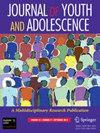(In)Congruence Effect of Individual and Classroom Victimization on Internalizing Problems: Examine Healthy Context Paradox Using Response Surface Analysis.
IF 3.6
1区 心理学
Q1 PSYCHOLOGY, DEVELOPMENTAL
引用次数: 0
Abstract
Previous research on Healthy Context Paradox has focused on how classroom environment shapes the emotional consequences (e.g., anxiety and depression) of bullying victimization, while limited attention to individual characteristics (e.g., psychological resilience) as potential moderators. Additionally, a better understanding Healthy Context Paradox mechanism requires assessing nonlinear effects of individual and classroom victimization on adolescents' internalizing problems. This study collected longitudinal data from 1029 adolescents over a 20-month period (Time 1: N = 1358, 49.5% girls, Mage ± SD = 12.38 ± 0.53; Time 2: N = 1029, 54.3% girls, Mage ± SD = 12.37 ± 0.49). Polynomial regression and multilevel average response surface analysis showed a linear effect, with higher level in individual and classroom victimization predicted worse outcomes. Moderated response surface analysis revealed that at low resilience level, greater incongruence between individual and classroom victimization predicted more internalizing problems, but this association became non-significant at high resilience level. These findings extended the Healthy Context Paradox and inform interventions to mitigate negative psychological outcomes among victims in seemingly healthy environments.(三)个体受害与课堂受害对内化问题的一致性效应:用反应面分析检验健康情境悖论。
以往关于健康情境悖论的研究主要集中在课堂环境如何塑造欺凌受害者的情绪后果(如焦虑和抑郁),而对个体特征(如心理弹性)作为潜在调节因素的关注有限。此外,为了更好地理解健康情境悖论机制,需要评估个体和课堂受害对青少年内化问题的非线性影响。本研究收集了1029名青少年在20个月期间的纵向数据(时间1:N = 1358, 49.5%的女孩,Mage±SD = 12.38±0.53;时间2:N = 1029, 54.3%的女孩,法师±SD = 12.37±0.49)。多项式回归和多水平平均反应面分析显示线性效应,个体和课堂受害程度越高,结果越差。调节反应面分析显示,在低弹性水平下,个体受害与课堂受害之间的不一致性越大,内化问题越多,但在高弹性水平下,这种关联变得不显著。这些发现扩展了健康环境悖论,并为干预措施提供了信息,以减轻在看似健康的环境中受害者的负面心理后果。
本文章由计算机程序翻译,如有差异,请以英文原文为准。
求助全文
约1分钟内获得全文
求助全文
来源期刊

Journal of Youth and Adolescence
PSYCHOLOGY, DEVELOPMENTAL-
CiteScore
8.20
自引率
6.10%
发文量
155
期刊介绍:
Journal of Youth and Adolescence provides a single, high-level medium of communication for psychologists, psychiatrists, biologists, criminologists, educators, and researchers in many other allied disciplines who address the subject of youth and adolescence. The journal publishes quantitative analyses, theoretical papers, and comprehensive review articles. The journal especially welcomes empirically rigorous papers that take policy implications seriously. Research need not have been designed to address policy needs, but manuscripts must address implications for the manner society formally (e.g., through laws, policies or regulations) or informally (e.g., through parents, peers, and social institutions) responds to the period of youth and adolescence.
 求助内容:
求助内容: 应助结果提醒方式:
应助结果提醒方式:


